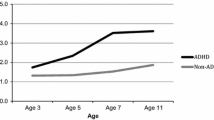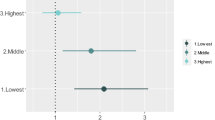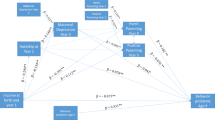Abstract
It has been unclear whether an associations of child ADHD with socio-economic disadvantage (SES) could be accounted for by (a) parental ADHD explaining both low SES and child ADHD, and/or (b) the joint overlap of ODD or CD with low SES and ADHD. Study 1 used a community-recruited case-control sample with detailed evaluation of SES indicators, child ADHD, child externalizing, and parent ADHD symptoms (n = 931 children, 521 ADHD, 577 boys, 354 girls) in a path modeling analysis with latent variables. Study 2 evaluated ADHD and externalizing behavior in a regression model using a poverty index for SES, in 70,927 children (48.2% female) aged 5–17 years from the US 2011–2012 National Survey of Children’s Health (NSCH). In Study 1, lower SES was related to the ADHD latent variable, β = −.18, p < .001; 95%CI [−.25,-.12]. This effect held when parent ADHD and child ODD and CD were in the model, β = −.11, p < .01, 95% CI [−.09,-.03], equivalent to OR = 1.50, 95% CI[1.12–2.04]). In Study 2, these results replicated. Adjusting only for age and sex, children from families who were below 200% of the federal poverty line were more likely to have moderate or severe ADHD than no ADHD, versus children above that line, OR = 2.13, 95% CI[1.79,2.54], p < .001. The effect held after adjusting for disruptive/externalizing problems, OR = 1.61, p < .01, 95%CI [1.32,1.96]. The effect size for comparable models was similar across both studies, lending higher confidence to the results. It is concluded that the SES association with child ADHD is not explained by artifact and requires a mechanistic explanation.

Similar content being viewed by others
Notes
A potential confound in the Nam-Powers-Boyd system is that it scores an occupation score = “0” for a range of reasons. In our sample, the breakdown was as follows: Unemployed (n = 23), plus n = 54 others that might be debatable: active military (n = 1), retired (n = 7), disabled (n = 5), students (n = 22), homemaker (n = 19). In a robustness analysis, we recoded these n = 54 scores that as missing. We repeated this for all the models (with slight change in N as reported below). Results were essentially unchanged and conclusions remained the same. We therefore report the results with the code as recommended (Nam and Boyd 2004). The robustness results are available on request.
In a path model, a hypothesized bidirectional effect gets two straight arrows, one pointing in each direction. However, models containing bidirectional effects can only be estimated given strong assumptions and other variables (or instruments) that cause each of the two variables involved in the bidirectional effect; therefore, we did not consider them viable here.
To obtain fit statistics for an SEM with a dichotomous outcome variable requires the robust weighted least squares estimator. We ran all of our models using both the robust weighted least squares and robust maximum likelihood estimators and received nearly identical results. We present the results using the robust weighted least squares estimator so that the reader has sufficient information to assess model fit.
References
American Psychological Association. (2007). Task Force on Socioeconomic Status. Report of the APA Task Force on Socioeconomic Status. Retrieved from https://www.apa.org/pi/ses/resources/publications/task-force-2006.pdf
Andreasen, N. C., Endicott, J., Spitzer, R. L., & Winokur, G. (1978). The family history method using diagnostic criteria. Nursing Research, 27(2), 140.
Arbuckle, J. L. (1996). Full information estimation in the presence of incomplete data. In G. A. Marcoulides & R. E. Schumacker (Eds.), Advanced structural equation modeling (pp. 243–277). Mahwah: Erlbaum.
Barkley, R. A. (2011). Barkley Adult ADHD Rating Scale-IV (BAARS-IV). New York: Guilford Publications.
Barkley, R. A. (Ed.). (2014). Attention-deficit hyperactivity disorder: A handbook for diagnosis and treatment (4th ed.). New York: Guilford Publications.
Barkley, R. A., & Fischer, M. (2010). The unique contribution of emotional impulsiveness to impairment in major life activities in hyperactive children as adults. Journal of the American Academy of Child and Adolescent Psychiatry, 49(5), 503–513.
Barkley, R. A., Murphy, K. R., & Fischer, M. (2010). ADHD in adults: What the science says. New York: Guilford Publications.
Bauermeister, J. J., Shrout, P. E., Chávez, L., Rubio-Stipec, M., Ramírez, R., Padilla, L., et al. (2007). ADHD and gender: are risks and sequela of ADHD the same for boys and girls? Journal of Child Psychology and Psychiatry, 48(8), 831–839.
Bentler, P. M. (1990). Comparative fit indexes in structural models. Psychological Bulletin, 107(2), 238–246.
Biederman, J., Faraone, S. V., & Monuteaux, M. C. (2002). Differential effect of environmental adversity by gender: Rutter’s index of adversity in a group of boys and girls with and without ADHD. American Journal of Psychiatry, 159(9), 1556–1562.
Blair, C., Raver, C. C., Granger, D., Mills-Koonce, R., & Hibel, L. (2011). Allostasis and allostatic load in the context of poverty in early childhood. Development and Psychopathology, 23(03), 845–857.
Bøe, T., Øverland, S., Lundervold, A. J., & Hysing, M. (2012). Socioeconomic status and children’s mental health: results from the Bergen Child Study. Social Psychiatry and Psychiatric Epidemiology, 47(10), 1557–1566.
Borenstein, M., Hedges, L. V., Higgins, J. P. T., & Rothstein, H. R. (2009). Introduction to Meta-Analysis. Chichester: John Wiley & Sons, Ltd..
Bowles, S., Gintis, H., & Groves, M. O. (Eds.). (2009). Unequal chances: Family background and economic success. Princeton: Princeton University Press.
Bradley, R. H., & Corwyn, R. F. (2002). Socioeconomic status and child development. Annual Review of Psychology, 53(1), 371–399.
Brosschot, J. F., Pieper, S., & Thayer, J. F. (2005). Expanding stress theory: Prolonged activation and perseverative cognition. Psychoneuroendocrinology, 30(10), 1043–1049.
Browne, M. W., Cudeck, R., Bollen, K. A., & Long, J. S. (1993). Alternative ways of assessing model fit. Sage Focus Editions, 154, 136–136.
Champagne, F. A., & Curley, J. P. (2005). How social experiences influence the brain. Current Opinion in Neurobiology, 15(6), 704–709.
Chang, Z., Lichtenstein, P., Asherson, P. J., & Larsson, H. (2013). Developmental twin study of attention problems: high heritabilities throughout development. JAMA Psychiatry, 70(3), 311–318. https://doi.org/10.1001/jamapsychiatry.2013.287.
Conners, C. K. (2008). Conners 3rd Edition Manual. North Tonawanda: Multi-Health Systems, Inc..
Conners, C. K., Erhardt, D., & Sparrow, E. (1999). Conners Adult ADHD Rating Scales (CAARS) Technical Manual. North Tonawanda: Multi-Health Systems, Inc..
Connor, D. F. (2002). Preschool attention deficit hyperactivity disorder: a review of prevalence, diagnosis, neurobiology, and stimulant treatment. Journal of Developmental and Behavioral Pediatrics, 23(1 Suppl), S1–S9.
Counts, C. A., Nigg, J. T., Stawicki, J. A., Rappley, M. D., & Von Eye, A. (2005). Family adversity in DSM-IV ADHD combined and inattentive subtypes and associated disruptive behavior problems. Journal of the American Academy of Child and Adolescent Psychiatry, 44(7), 690–698.
Dohrenwend, B. P., & Dohrenwend, B. S. (1969). Social status and psychological disorder: A causal inquiry. New York: John Wiley & Sons, Ltd..
DuPaul, G. J., Power, T. J., Anastopoulos, A. D., & Reid, R. (1998). ADHD Rating Scale—IV: Checklists, norms, and clinical interpretation. New York: Guilford Publications.
Evans, G. W. (2004). The environment of childhood poverty. American Psychologist, 59(2), 77–92. https://doi.org/10.1037/0003-066X.59.2.77.
Faraone, S. V., & Mick, E. (2010). Molecular genetics of attention deficit hyperactivity disorder. Psychiatric Clinics of North America, 33(1), 159–180.
Faris, R. E. L., & Dunham, H. W. (1939/1960). Mental disorders in urban areas: An ecological study of schizophrenia and other psychoses. New York: Hafner Publishing Company.
Ford, T., Goodman, R., & Meltzer, H. (2004). The relative importance of child, family, school and neighbourhood correlates of childhood psychiatric disorder. Social Psychiatry and Psychiatric Epidemiology, 39(6), 487–496.
Ford-Jones, P. C. (2015). Misdiagnosis of attention deficit hyperactivity disorder: 'Normal behaviour' and relative maturity. Paediatrics & Child Health, 20(4), 200–202.
Foulon, S., Pingault, J. B., Larroque, B., Melchior, M., Falissard, B., & Cote, S. M. (2015). Developmental predictors of inattention-hyperactivity from pregnancy to early childhood. PLoS One, 10(5), e0125996. https://doi.org/10.1371/journal.pone.0125996.
Froehlich, T. E., Lanphear, B. P., Epstein, J. N., Barbaresi, W. J., Katusic, S. K., & Kahn, R. S. (2007). Prevalence, recognition, and treatment of attention-deficit/hyperactivity disorder in a national sample of US children. Archives of Pediatrics and Adolescent Medicine, 161(9), 857–864.
Ganzel, B. L., Morris, P. A., & Wethington, E. (2010). Allostasis and the human brain: Integrating models of stress from the social and life sciences. Psychological Review, 117(1), 134–174. https://doi.org/10.1037/a0017773.
Goodman, R. (2001). Psychometric properties of the Strengths and Difficulties Questionnaire. Journal of the American Academy of Child and Adolescent Psychiatry, 40(11), 1337–1345. https://doi.org/10.1097/00004583-200111000-00015.
Hackman, D. A., Farah, M. J., & Meaney, M. J. (2010). Socioeconomic status and the brain: mechanistic insights from human and animal research. Nature Reviews Neuroscience, 11(9), 651–659.
Hanscombe, K. B., Trzaskowski, M., Haworth, C. M., Davis, O. S., Dale, P. S., & Plomin, R. (2012). Socioeconomic status (SES) and children's intelligence (IQ): in a UK-representative sample SES moderates the environmental, not genetic, effect on IQ. PLoS One, 7(2), e30320. https://doi.org/10.1371/journal.pone.0030320.
Hollingshead, A. B., & Redlich, F. C. (1958). Social class and mental illness: Community study. New York: John Wiley & Sons, Ltd..
Hu, L., & Bentler, P. M. (1999). Cutoff criteria for fit indexes in covariance structure analysis: Conventional criteria versus new alternatives. Structural Equation Modeling: A Multidisciplinary Journal, 6(1), 1–55.
Kenny, D. A. (1979). Correlation and Causality. New York: John Wiley & Sons.
Kim, J., Mutyala, B., Agiovlasitis, S., & Fernhall, B. (2011). Health behaviors and obesity among US children with attention deficit hyperactivity disorder by gender and medication use. Preventive Medicine, 52(3–4), 218–222.
Larsson, H., Sariaslan, A., Långström, N., D'Onofrio, B. M., & Lichtenstein, P. (2014). Family income in early childhood and subsequent attention deficit/hyperactivity disorder: a quasi-experimental study. Journal of Child Psychology and Psychiatry, 55(5), 428–435.
Lingineni, R. K., Biswas, S., Ahmad, N., Jackson, B. E., Bae, S., & Singh, K. P. (2012). Factors associated with attention deficit/hyperactivity disorder among US children: results from a national survey. BMC Pediatrics, 12, 50. https://doi.org/10.1186/1471-2431-12-50.
Liston, C., Miller, M. M., Goldwater, D. S., Radley, J. J., Rocher, A. B., Hof, P. R., et al. (2006). Stress-induced alterations in prefrontal cortical dendritic morphology predict selective impairments in perceptual attentional set-shifting. Journal of Neuroscience, 26(30), 7870–7874.
Liston, C., McEwen, B. S., & Casey, B. J. (2009). Psychosocial stress reversibly disrupts prefrontal processing and attentional control. Proceedings of the National Academy of Sciences, 106(3), 912–917.
Loe, I. M., & Feldman, H. M. (2007). Academic and educational outcomes of children with ADHD. Journal of Pediatric Psychology, 32(6), 643–654.
Loeber, R., Green, S. M., Keenan, K., & Lahey, B. B. (1995). Which boys will fare worse? Early predictors of the onset of conduct disorder in a six-year longitudinal study. Journal of the American Academy of Child and Adolescent Psychiatry, 34(4), 499–509.
Mannuzza, S., Klein, R. G., Bessler, A., Malloy, P., & Hynes, M. E. (1997). Educational and occupational outcome of hyperactive boys grown up. Journal of the American Academy of Child and Adolescent Psychiatry, 36(9), 1222–1227.
McEwen, B. S. (2007). Physiology and neurobiology of stress and adaptation: central role of the brain. Physiological Reviews, 87(3), 873–904.
McEwen, B. S. (2015). Biomarkers for assessing population and individual health and disease related to stress and adaptation. Metabolism, Clinical and Experimental, 64(3 Suppl 1), S2–S10. https://doi.org/10.1016/j.metabol.2014.10.029.
McEwen, B. S., & Gianaros, P. J. (2010). Central role of the brain in stress and adaptation: links to socioeconomic status, health, and disease. Annals of the New York Academy of Sciences, 1186(1), 190–222.
McEwen, B. S., Eiland, L., Hunter, R. G., & Miller, M. M. (2012). Stress and anxiety: structural plasticity and epigenetic regulation as a consequence of stress. Neuropharmacology, 62(1), 3–12.
McLaughlin, K. A., Costello, E. J., Leblanc, W., Sampson, N. A., & Kessler, R. C. (2012). Socioeconomic status and adolescent mental disorders. American Journal of Public Health, 102(9), 1742–1750. https://doi.org/10.2105/ajph.2011.300477.
Merikangas, K. R., He, J.-P., Burstein, M., Swanson, S. A., Avenevoli, S., Cui, L., et al. (2010). Lifetime prevalence of mental disorders in US adolescents: results from the National Comorbidity Survey Replication–Adolescent Supplement (NCS-A). Journal of the American Academy of Child and Adolescent Psychiatry, 49(10), 980–989.
Miech, R. A., Caspi, A., Moffitt, T. E., Wright, B. R. E., & Silva, P. A. (1999). Low socioeconomic status and mental disorders: a longitudinal study of selection and causation during young adulthood 1. American Journal of Sociology, 104(4), 1096–1131.
Mills, C. (2015). The psychiatrization of poverty: Rethinking the mental health-poverty nexus. Social and Personality Psychology Compass, 9(5), 213–222.
Muthen, L. K., & Muthen, B. O. (1998-2012). Mplus User's Guide. Seventh Edition. Los Angeles, CA: Muthen and Muthen.
Nam, C. B., & Boyd, M. (2004). Occupational status in 2000; over a century of census-based measurement. Population Research and Policy Review, 23(4), 327–358.
Nigg, J. T. (2012). Future directions in ADHD etiology research. Journal of Clinical Child and Adolescent Psychology, 41(4), 524–533. https://doi.org/10.1080/15374416.2012.686870.
Nigg, J. T. (2016). Where do epigenetics and developmental origins take the field of developmental psychopathology? Journal of Abnormal Child Psychology, 44(3), 405–419. https://doi.org/10.1007/s10802-015-0121-9.
Pluess, M. (2017). Vantage sensitivity: Environmental sensitivity to positive experiences as a function of genetic differences. Journal of Personality, 85(1), 38–50.
Pluess, M., & Belsky, J. (2013). Vantage sensitivity: individual differences in response to positive experiences. Psychological Bulletin, 139(4), 901–916. https://doi.org/10.1037/a0030196.
Polanczyk, G., de Lima, M. S., Horta, B. L., Biederman, J., & Rohde, L. A. (2007). The worldwide prevalence of ADHD: a systematic review and metaregression analysis. American Journal of Psychiatry, 164(6), 942–948.
Puig-Antich, J., & Ryan, N. (1996). Schedule for affective disorders and schizophrenia. Pittsburgh: Western Psychiatric Institute and Clinic.
Reiss, F. (2013). Socioeconomic inequalities and mental health problems in children and adolescents: a systematic review. Social Science and Medicine, 90, 24–31.
Rogosch, F. A., Dackis, M. N., & Cicchetti, D. (2011). Child maltreatment and allostatic load: Consequences for physical and mental health in children from low-income families. Development and Psychopathology, 23(04), 1107–1124.
Roth, T. L. (2012). Epigenetics of neurobiology and behavior during development and adulthood. Developmental Psychobiology, 54(6), 590–597.
Russell, A. E., Ford, T., & Russell, G. (2015). Socioeconomic associations with ADHD: findings from a mediation analysis. PLoS One, 10(6), e0128248.
Russell, A. E., Ford, T., Williams, R., & Russell, G. (2016). The association between socioeconomic disadvantage and attention deficit/hyperactivity disorder (ADHD): a systematic review. Child Psychiatry and Human Development, 47(3), 440–458.
Santiago, C. D., Wadsworth, M. E., & Stump, J. (2011). Socioeconomic status, neighborhood disadvantage, and poverty-related stress: Prospective effects on psychological syndromes among diverse low-income families. Journal of Economic Psychology, 32(2), 218–230.
Shumacker, R. E., & Lomax, R. G. (1996). A beginner’s guide to structural equation modeling. NJ Erlbaum: Mahwah.
Silver, E., Mulvey, E. P., & Swanson, J. W. (2002). Neighborhood structural characteristics and mental disorder: Faris and Dunham revisited. Social Science and Medicine, 55(8), 1457–1470.
Szatmari, P., Boyle, M., & Offord, D. R. (1989). ADDH and conduct disorder: degree of diagnostic overlap and differences among correlates. Journal of the American Academy of Child and Adolescent Psychiatry, 28(6), 865–872.
Thayer, Z. M., & Kuzawa, C. W. (2011). Biological memories of past environments: epigenetic pathways to health disparities. Epigenetics, 6(7), 798–803.
Tucker, L. R., & Lewis, C. (1973). A reliability coefficient for maximum likelihood factor analysis. Psychometrika, 38(1), 1–10.
Turkheimer, E., Haley, A., Waldron, M., D'Onofrio, B., & Gottesman, I. I. (2003). Socioeconomic status modifies heritability of IQ in young children. Psychological Science, 14(6), 623–628. https://doi.org/10.1046/j.0956-7976.2003.psci_1475.x.
USA National Survey of Children's Health 2011-2012: Child and adolescent health measurement initiative. (2014). Retrieved from Centers for Disease Control Center for Health Statistics: www.childhealthdata.org
Van Os, J., Marcelis, M., Sham, P., Jones, P., Gilvarry, K., & Murray, R. (1997). Psychopathological syndromes and familial morbid risk of psychosis. The British Journal of Psychiatry, 170(3), 241–246.
Van Praag, H., Kempermann, G., & Gage, F. H. (2000). Neural consequences of enviromental enrichment. Nature Reviews Neuroscience, 1(3), 191–198.
Verdoux, H., Van Os, J., Sham, P., Jones, P., Gilvarry, K., & Murray, R. (1996). Does familiality predispose to both emergence and persistence of psychosis? A follow-up study. The British Journal of Psychiatry, 168(5), 620–626.
Visser, S. N., Danielson, M. L., Bitsko, R. H., Holbrook, J. R., Kogan, M. D., Ghandour, R. M., et al. (2014). Trends in the parent-report of health care provider-diagnosed and medicated attention-deficit/hyperactivity disorder: United States, 2003–2011. Journal of the American Academy of Child and Adolescent Psychiatry, 53(1), 34–46.e32.
Visser, S. N., Zablotsky, B., Holbrook, J. R., Danielson, M. L., & Bitsko, R. H. (2015). Diagnostic experiences of children with Attention-Deficit/Hyperactivity Disorder. National Health Statistics Reports, 81, 1–7.
Waring, M. E., & Lapane, K. L. (2008). Overweight in children and adolescents in relation to attention-deficit/hyperactivity disorder: results from a national sample. Pediatrics, 122(1), e1–e6.
Wechsler, D. (2003). Wechsler intelligence scale for children–Fourth Edition (WISC-IV). San Antonio: The Psychological Corporation.
Wechsler, D. (2009). Wechsler Individual Achievement Test, 3rd Edition (WIAT-III). New York: Pearson, Inc..
Wolraich, M., Brown, L., Brown, R. T., DuPaul, G., Earls, M., Feldman, H. M., et al. (2011). ADHD: clinical practice guideline for the diagnosis, evaluation, and treatment of attention-deficit/hyperactivity disorder in children and adolescents. Pediatrics, 128(5), 1007–1022. https://doi.org/10.1542/peds.2011-2654.
Funding
This work was funded by NIMH grant R37–59105 (Nigg, PI).
Author information
Authors and Affiliations
Corresponding author
Ethics declarations
Conflict of Interest
The authors declare no conflicts of interest relevant to this work.
Ethical Approval
All procedures performed in studies involving human participants were in accordance with the ethical standards of the institutional and/or national research committee and with the 1964 Helsinki declaration and its later amendments or comparable ethical standards.
Informed Consent
Written informed consent was obtained from all parents participating in the study, one parent provided written informed consent for all children participating in the study, and written informed assent was obtained from all participating children.
Electronic Supplementary Material
ESM 1
(DOCX 987 kb)
Rights and permissions
About this article
Cite this article
Miller, L.L., Gustafsson, H.C., Tipsord, J. et al. Is the Association of ADHD with Socio-Economic Disadvantage Explained by Child Comorbid Externalizing Problems or Parent ADHD?. J Abnorm Child Psychol 46, 951–963 (2018). https://doi.org/10.1007/s10802-017-0356-8
Published:
Issue Date:
DOI: https://doi.org/10.1007/s10802-017-0356-8




